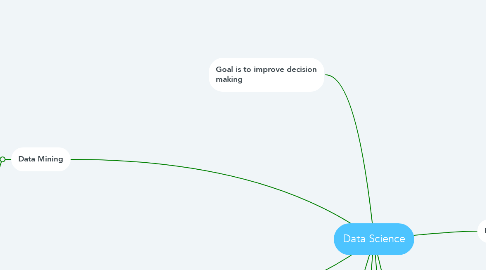
1. Data Driven Decision Making
1.1. Affects a firm's performance
1.1.1. 4-6% increase in productivity
1.1.2. Higher return on assets, return on equity, asset utilization and market value
1.2. Two types of decision making
1.2.1. Decisions in which discoveries need to made within data.
1.2.1.1. Walmart discovering new knowledge that will help them prepare for a hurricanes arrival
1.2.2. Decisions that repeat at a massive scale
1.2.2.1. MegaTelCo utilizes their vast data resources to decide which customers to focus on
1.3. Basing decisions on the analysis of data rather than purely on intuition.
1.4. Involves principles, processes, and techniques for understanding automated analysis of date
2. Data Mining
2.1. actual extraction of knowledge from data via technologies that incorporate these principles
2.1.1. Fundamental Principles & Techniques
2.1.1.1. Functional Areas of Business
2.1.1.1.1. Marketing
2.1.1.1.2. Finance
2.1.1.1.3. Retail
3. Goal is to improve decision making
4. Data Processing
4.1. Data engineering and processing are critical to support data-science activities
4.2. Data-processing technologies are important for many business tasks that do not involve extracting knowledge or data-driven decision making
4.2.1. Online advertising campaign management
4.2.2. Efficient transaction processing
4.2.3. Modern web system processing
5. "Big Data"
5.1. "Big data" means datasets that are too large for traditional data-processing systems
5.1.1. Used for implementing data mining techniques
5.1.1.1. Require new technologies
5.1.1.1.1. Big Data 1.0
5.1.2. Used for data processing in support of the data-mining techniques
6. Data-Analytic Thinking
6.1. Important for improving data driven decision making.
6.1.1. Data driven investment analysis
6.1.1.1. Investment useless if data not properly incorporated into complex decision making
6.1.1.2. Data analytics projects reach into all business units necessitating proper analysis
6.1.2. Used to analyze data projects
6.2. Analyze data-driven competitive threats
6.3. Helps to develop questions to help with valuation determination
6.4. Better communication
6.4.1. Allows non-data roles to communicate better with data-science teams
6.4.2. Lack of communication leads to wasted time and effort
6.4.3. Wrong decisions
7. Fundamental Concepts
7.1. The relationship between business problem and analytics solution can be decomposed into tractable subproblems via the framework of analyzing expected value.
7.1.1. Break business issues separate components
7.1.1.1. Recombine components to solve bigger problem
7.1.1.2. Proper phrasing will allow identification of components necessary
7.2. Evaluating data-science results requires careful consideration of the context in which will be used
7.2.1. Many data science evaluation frameworks are based on this concept
7.2.1.1. Context dictates a particular set of data's helpfulness
7.3. Extracting useful knowledge from data to solve business problems, treated systematically by following process with reasonably well-defined stages
7.3.1. Differentiates between
7.3.1.1. Creative thinking
7.3.1.2. Structured problem solving
7.3.2. CRISP-DM
7.3.2.1. Measurable and repeatable
7.4. Information technology used to find informative data items from within large body of data
7.4.1. Correlation
7.4.1.1. Statistical analysis
7.4.1.2. Predictive modeling
7.4.1.3. Other data mining
7.4.1.4. Data items that provide information about other data items
7.5. Entities similar with respect to known features or attributes similar with respect to unknown features or attributes
7.5.1. Main tool of data science
7.6. To draw causal conclusions, one must pay very close attention to the presence of confounding factors, possibly unseen ones
7.6.1. Not just correlation of data.
7.6.1.1. What is causing the correlation
8. Data Science Vs. Data Scientists
8.1. What activities dictate the field
8.1.1. Seperations between the field Technician vs. scientist
8.1.1.1. Skills required for data science
8.1.1.1.1. Analytical
8.1.1.1.2. Data processing
8.1.1.1.3. Data mining techniques
8.2. Defining the field
8.2.1. Universities setting up programs
8.2.2. More specifically defining the field
